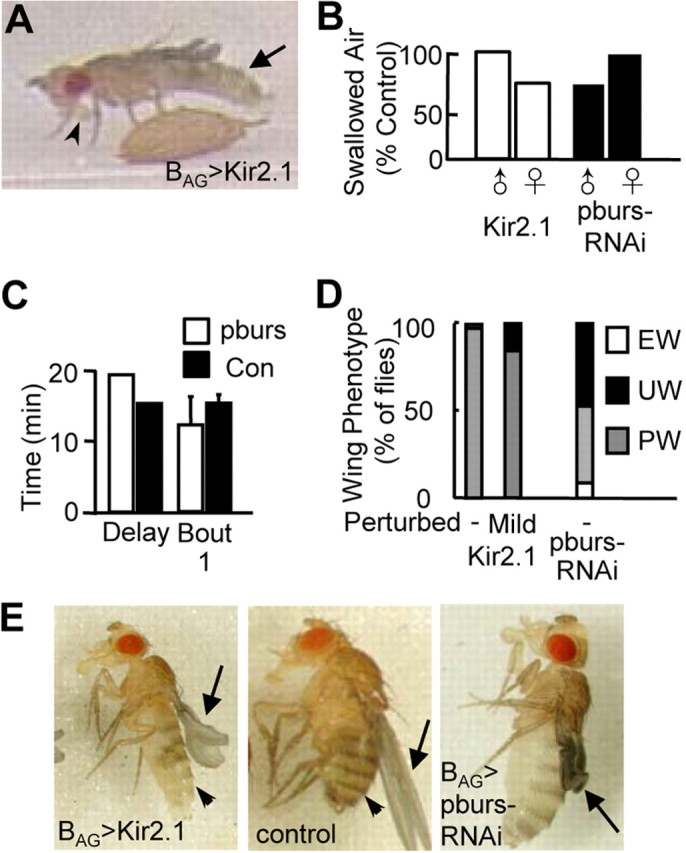Figure 5.

BAG suppression blocks somatic, but not behavioral, aspects of wing expansion. A, Video frame of a BAG>Kir2.1 fly showing that the execution of abdominal flexion (arrow) and proboscis extension required for air swallowing (arrowhead) are normal. B, Both BAG>Kir2.1 (left) and BAG>pburs-RNAi (right) flies swallow substantial amounts of air during the period of sustained abdominal flexion relative to matched controls (i.e., either flies lacking the DBD hemidriver or the UAS-pburs-RNAi transgene, respectively).  , males; ♀, females. C, Bar graphs showing the median time from eclosion to the onset of the first bout sustained abdominal flexion (Delay) and the average duration of the first bout (Bout 1) in BAG>pburs-RNAi flies (n = 7) versus matched controls (Con) lacking the UAS-pburs-RNAi transgene (n = 9). Error bars are SD. D, Wing expansion deficits observed in BAG>Kir2.1 flies in noninhibitory (−) and inhibitory (+) environments are similar (left) and somewhat less severe than those observed in BAG>pburs-RNAi flies (right). EW, Expanded wings, UW, unexpanded wings; PW, partially expanded wings. E, Left and middle, Wing expansion (arrow) and cuticle tanning (arrowhead) are impaired in BAG>Kir2.1 animals (left; note reduced pigmentation), relative to controls lacking the BAG hemidriver (middle). Right, the wings (arrow) of BAG>pburs-RNAi flies typically undergo little to no expansion during abdominal flexion.
, males; ♀, females. C, Bar graphs showing the median time from eclosion to the onset of the first bout sustained abdominal flexion (Delay) and the average duration of the first bout (Bout 1) in BAG>pburs-RNAi flies (n = 7) versus matched controls (Con) lacking the UAS-pburs-RNAi transgene (n = 9). Error bars are SD. D, Wing expansion deficits observed in BAG>Kir2.1 flies in noninhibitory (−) and inhibitory (+) environments are similar (left) and somewhat less severe than those observed in BAG>pburs-RNAi flies (right). EW, Expanded wings, UW, unexpanded wings; PW, partially expanded wings. E, Left and middle, Wing expansion (arrow) and cuticle tanning (arrowhead) are impaired in BAG>Kir2.1 animals (left; note reduced pigmentation), relative to controls lacking the BAG hemidriver (middle). Right, the wings (arrow) of BAG>pburs-RNAi flies typically undergo little to no expansion during abdominal flexion.
